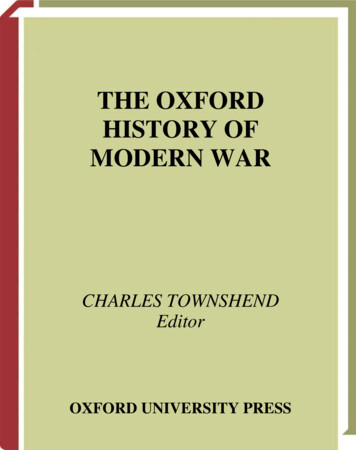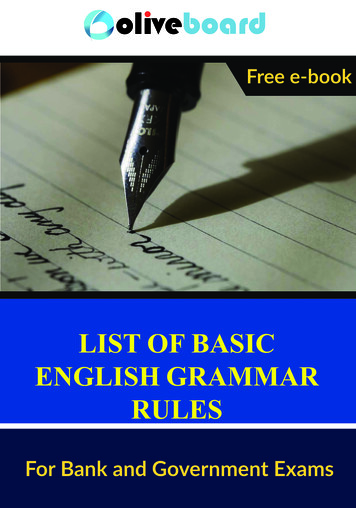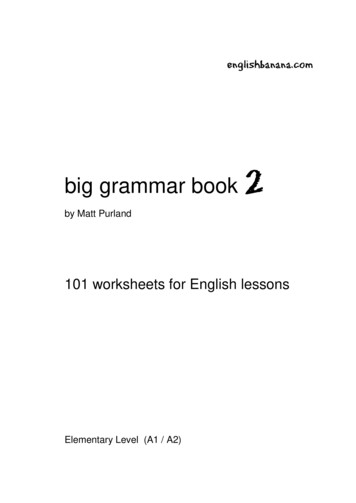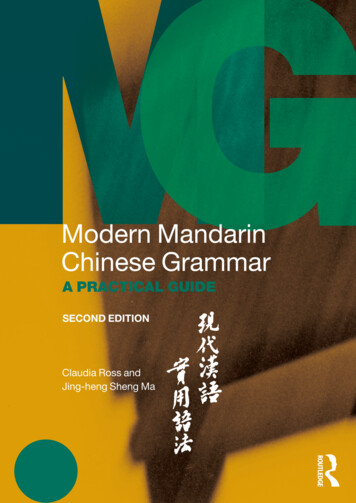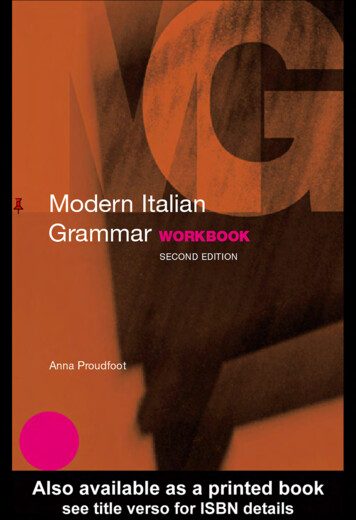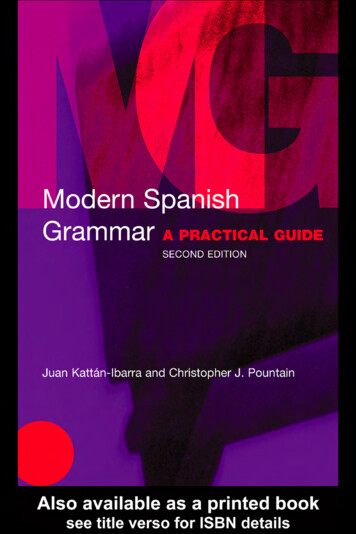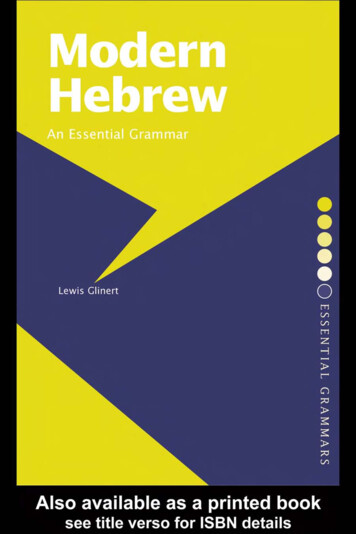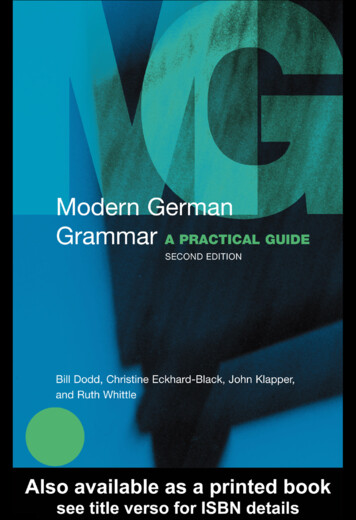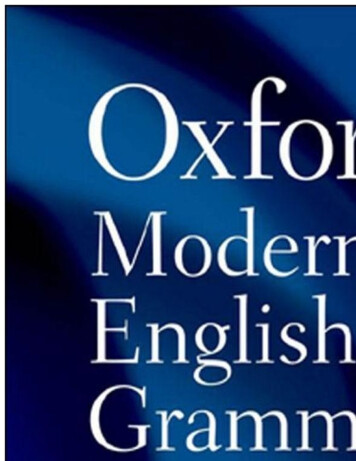
Transcription
Oxford Modern English Grammar
Bas Aarts is Professor of English Linguistics and Director of the Survey ofEnglish Usage at University College London. His previous books includeSmall Clauses in English: The Nonverbal Types (Mouton de Gruyter, 1992);The Verb in Contemporary English , co-edited with Charles F. Meyer(Cambridge University Press, 1995); English Syntax and Argumentation(Palgrave, 1997, 2001, 2008); Investigating Natural Language: Workingwith the British Component of the International Corpus of English , coauthored with Gerald Nelson and Sean Wallis (John Benjamins, 2002);Fuzzy Grammar: A Reader , co-edited with David Denison, Evelien Keizer,and Gergana Popova (Oxford University Press, 2004); The Handbook ofEnglish Linguistics , co-edited with April McMahon (Blackwell, 2006); andSyntactic Gradience: The Nature of Grammatical Indeterminacy (OxfordUniversity Press, 2007). He is one of the founding editors of the journalEnglish Language and Linguistics .
Oxford Modern English GrammarBas AartsDepartment of English Language and Literature University College London
Great Clarendon Street, Oxford OX 2 6DPOxford University Press is a department of the University of Oxford.It furthers the University’s objective of excellence in research, scholarship,and education by publishing worldwide inOxford New YorkAuckland Cape Town Dar es Salaam Hong Kong KarachiKuala Lumpur Madrid Melbourne Mexico City NairobiNew Delhi Shanghai Taipei TorontoWith offices inArgentina Austria Brazil Chile Czech Republic France GreeceGuatemala Hungary Italy Japan Poland Portugal SingaporeSouth Korea Switzerland Thailand Turkey Ukraine VietnamOxford is a registered trade mark of Oxford University Pressin the UK and in certain other countriesPublished in the United Statesby Oxford University Press Inc., New York Oxford University Press 2011The moral rights of the author have been assertedDatabase right Oxford University Press (maker)First published 2011All rights reserved. No part of this publication may be reproduced,stored in a retrieval system, or transmitted, in any form or by any means,without the prior permission in writing of Oxford University Press,or as expressly permitted by law, or under terms agreed with the appropriatereprographics rights organization. Enquiries concerning reproductionoutside the scope of the above should be sent to the Rights Department,Oxford University Press, at the address above
You must not circulate this book in any other binding or coverand you must impose the same condition on any acquirerBritish Library Cataloguing in Publication DataData availableLibrary of Congress Cataloging-in-Publication DataData availableTypeset by Glyph International, Bangalore, IndiaPrinted in Great Britainon acid-free paper byClays Ltd., St Ives plcISBN 978–0–19–953319–01 3 5 7 9 10 8 6 4 2
In memory of my mother Sjé Aarts-Postmes (1934–2008)
ContentsList of figuresList of tablesPrefaceNotational conventions and abbreviationsAbbreviationsPart I: The basicsChapter 1: An overview of English grammarPart II: Form and functionChapter 2: Word structure and word-formationChapter 3: Word classes and simple phrasesChapter 4: Grammatical functions, semantic roles, and tree diagramsPart III: Phrase and clause patternsChapter 5: Complex phrases and coordinationChapter 6: Clause types and negationChapter 7: Finite subordinate clausesChapter 8: Non-finite and verbless subordinate clausesPart IV: Grammar and meaningChapter 9: Tense and aspectChapter 10: Mood
Chapter 11: Information structuringAppendix 1: English irregular verbsAppendix 2: The structure of the ICE-GB corpusNotes and further readingList of sources of examplesReferencesSubject IndexLexical Index
List of figuresFigure 2.1: The field of morphologyFigure 3.1: The subclassification of English verbs
List of tablesTable2.1:The person systemTable2.2:The paradigm for the regular verb INSULTTable2.3:The paradigm for the irregular verb BREAKTable2.4:The progressive, perfect, and passive constructionsTable2.5:The present tense forms of the verb BETable2.6:Non-finite clausesTable2.7:Plural-formationTable2.8:The case forms of personal pronounsTable2.9:The inflectional forms of adjectives and adverbs
Table2.10:Some common derivational suffixesTable2.11:Some common derivational prefixesTable2.12:Compound nounsTable2.13:Compound verbsTable2.14:Compound adjectivesTable2.15:Compound prepositionsTable2.16:Compound adverbsTable2.17:Combining formsTable3.1:Word classesTable3.2:Some common nominal suffixes
Table3.3:The distributional properties of typical nounsTable3.4:Pronoun subclassesTable3.5:Reflexive pronounsTable3.6:Reciprocal pronounsTable3.7:Relative pronounsTable3.8:Interrogative pronounsTable3.9:Demonstrative pronounsTable3.10:Indefinite pronounsTable3.11:DeterminativesTable3.12:The distributional properties of typical determinatives
Table3.13:The distributional properties of typical adjectivesTable3.14:The modal auxiliariesTable3.15:The perfect constructionTable3.16:The progressive constructionTable3.17:The passive constructionTable3.18:Uses of dummy DOTable3.19:PrepositionsTable3.20:Complex bal prepositions
Table3.23:Subordinating conjunctionsTable4.1:Grammatical functionsTable4.2:The properties of typical SubjectsTable4.3:The properties of typical Direct ObjectsTable4.4:A selection of transitive verbsTable4.5:The properties of typical Indirect ObjectsTable4.6:A selection of ditransitive verbsTable4.7:A selection of linking verbsTable4.8:A selection of complex transitive verbsTable4.9:The distributional properties of typical PredicativeComplements
Table4.10:The distributional properties of PPCsTable4.11:A selection of verbs licensing PPCsTable4.12:The distributional properties of typical AdjunctsTable4.13:Semantic rolesTable5.1:Grammatical functions at phrase levelTable5.2:Determiners in noun phrasesTable5.3:Predeterminers in noun phrasesTable5.4:Complements in noun phrasesTable5.5:Adjuncts in noun phrasesTable5.6:Complements in adjective phrases
Table5.7:Adjuncts in adjective phrasesTable5.8:Complements in verb phrasesTable5.9:Basic complementation patternsTable5.10:An overview of constructions involving non-locative PPsfunctioning as PPCTable5.11:An overview of constructions involving locative PPsfunctioning as PPCTable5.12:Adjuncts in verb phrasesTable5.13:Complements in prepositional phrasesTable5.14:Conjunctive prepositionsTable5.15:Conjunctive complex prepositionsTable5.16:Adjuncts in prepositional phrases
Table5.17:Complements in adverb phrasesTable5.18:Adjuncts in adverb phrasesTable6.1:The properties of declarative clausesTable6.2:The properties of open interrogative clausesTable6.3:The properties of closed interrogative clausesTable6.4:The properties of imperative clausesTable6.5:The properties of exclamative clausesTable6.6:Overview of the clause types: syntax and useTable7.1:Finite subordinate clausesTable7.2:Content clauses
Table7.3:Verbs occurring in the pattern ‘DECIDE [ clause that ]’Table7.4:Verbs occurring in the pattern ‘WONDER [ clause if/whether/whphrase ]’Table7.5:Verbs occurring in the pattern ‘MENTION ([ PP to NP]) [ clause that ]’Table7.6:Verbs occurring in the pattern ‘TELL NP [ clause that ]’Table7.7:Verbs occurring in the pattern ‘ASK NP [ clause whether/if/whphrase ]’Table7.8:Verbs occurring in the pattern ‘PERSUADE NP [ clause that ]’Table7.9:Verbs occurring in the pattern ‘REMIND NP [ clause whether/if/ wh-phrase ]’Table7.10:Verbs occurring in the pattern ‘It SEEM (PP) [ clause (that/as if) ]’Table7.11:The scalar/non-scalar and equality/inequality contrastsTable8.1:Non-finite clauses
Table8.2:Verbs occurring in the pattern ‘WANT [ clause (for ) NP toinfinitive ]’Table8.3:Verbs occurring in the pattern ‘HESITATE [ clause , Ø to- [ clauseinfinitive ]’Table8.4:Verbs occurring in the pattern ‘WONDER [ clause whether/whphrase Ø to -infinitive ]’Table8.5:Verbs occurring in the pattern ‘TELL NPi [ clause Øi toinfinitive ]’Table8.6:Verbs occurring in the pattern ‘TELL NPi [ clause wh -phrase Øi to infinitive ]’Table8.7:Verbs occurring in the pattern ‘PERSUADE NPi [ clause Øi toinfinitive ]’Table8.8:Verbs occurring in the pattern ‘ADVISE NPi [ clause whether/whphrase Øi to-infinitive ]’Table8.9:Table8.10:Table8.11:Verbs occurring in the pattern ‘HAVE [ clause NP bareinfinitive ]’
Table8.12:Verbs occurring in the patternbare infinitive ]’Table8.13:Verbs occurring in the pattern ‘REMEMBER [ clause Ø-ingparticiple ]’Table8.14:Verbs occurring in the pattern ‘RECOMMEND [ clause NP/NP’s -ingparticiple ]’Table8.15:Table8.16:-ingVerbs occurring in the pattern ‘PREVENTparticiple ]]’Verbs occurring in the pattern ‘REGARDparticiple ]]’-ingTable8.17:Verbs occurring in the pattern ‘FIND NPi [ clause Øi -ingparticiple ]’Table8.18:Verbs occurring in the pattern ‘DESCRIBE NPi [ PP as [ clause Øi ing participle ]]’Table8.19:Table8.20:Verbs occurring in the pattern ‘HAVE [ clause NP pastparticiple ]’
Table10.1:Frequencies of the English core modal auxiliaries per millionwords in the ICE-GB corpusTable10.2:The morphosyntactic properties of the modal verbsTable10.3:The uses of WILL /wouldTable10.4:The uses of SHALLTable10.5:The uses of shouldTable10.6:The uses of CAN / couldTable10.7:The uses of MAY /mightTable10.8:The uses of MUST
PrefaceThe aim of this grammar is to offer a modern, concise, but neverthelesswide-ranging description of the structure of contemporary standard Britishand American English. The book is intended for anyone who is interested inEnglish grammar, and has been written without an assumption on my partthat the reader has any previous knowledge of grammatical concepts.The account of grammar presented in this book is descriptive, notprescriptive: it describes the language as it is used today. Readers hoping tofind confirmation that the so-called split infinitive is an odiousmanifestation of the decline of the English language—to give but oneexample of a common usage shibboleth—will be disappointed. The viewtaken here is that the English language is not a static entity, but iscontinually subject to inevitable change, which is reflected in its lexis andgrammar.It is not possible to write a book like this without acknowledging previouswork on English grammar. The framework adopted here relies heavily onthe two most complete and in-depth accounts of English grammar currentlyavailable, namely Randolph Quirk, Sidney Greenbaum, Geoffrey Leech,and Jan Svartvik’s Comprehensive Grammar of the English Language(1985) and Rodney Huddleston and Geoffrey Pullum et al.’s CambridgeGrammar of the English Language (2002). These grammars offersophisticated and detailed descriptions of English that go far beyond thescope of the present book. It should be noted, however, that I have not in allcases followed the grammatical analyses presented in these books. Themajor points of divergence are discussed in the Notes and further readingsection.I owe an enormous debt of gratitude to Flor Aarts, Peter Collins, RodneyHuddleston, and Geoffrey Leech (in alphabetical order) for reading theentire manuscript and commenting on it in great detail. I am very fortunateto have received this tremendously valuable feedback from such eminentgrammarians, and their input has made this a much better book than itwould otherwise have been. I’m also grateful to my editors at OxfordUniversity Press, Ben Harris, Vicky Donald, Rebecca Lane and Clare
Jenkins. For their help during the editing stage I would like to thank JillBowie for her superb copy-editing, Helen Liebeck for proofreading, andPhil Aslett for compiling the subject index.BAS AARTSUniversity College LondonApril 2010
Notational conventions and abbreviationsNotational conventions*An asterisk indicates an impossible structure, i.e. astructure that does not conform to the grammatical rules ofEnglish. Example: *They likes to read . In this examplethe third person plural Subject they is followed by a verbwith a third person singular inflectional ending.ØThis symbol is used to indicate an implicit Subject.Example: I want [Ø to read it].Ørel.This is used to indicate an implicit relativized element.Example: The power [that Ørel enables this union]Coleridge categorized as the imagination .ØsubThis is used to indicate a missing subordinatingconjunction that . Example: They think [Øsub they arefunny ]. This symbol is used where the form label can be ofdifferent kinds (that is, where the function can be realizedby different kinds of forms).arrowsThese indicate movement, e.g. passivization,extraposition, or raising. Example:to enjoycricket . The underscore symbol is explained below.bracketsBrackets are used:
[ ](1) to indicate words that together form a constituentphrase, clause, etc. A labelled bracketing includes asubscript indicator of the syntactic status of theconstituent. Example: [ NP Cats ] [VP eat [ NP fish ]]; (2) toindicate that a lexical item, usually a verb, is followed bya Complement which contains a particular word. Example:HAVE [to ] indicates that the verb HAVE is followed by aComplement that contains the word to , e.g. I have toleave .capitalsThese are used:(1) to indicate functional grammatical labels, e.g. Subject,Direct Object;(2) semantic roles, e.g. Agent, Patient.coindexingItems that are coreferential can be coindexed, i.e. bear thesame subscript letter, usually an ‘i’. Example: He i shaveshimselfi twice every day .italicsThese are used:(1) to indicate the first time a particular technical term isused;(2) to cite words, sentences, etc. as linguistic forms;(3) to indicate words, phrases, etc. that requirehighlighting. For underlined italics, see below.SMALLCAPSThese indicate lexemes (i.e. dictionary words). Example:the forms laugh, laughs, laughed , and laughing areinflectional forms belonging to the lexeme LAUGH . Thesmall caps notation will be used for verbs throughout, andfor other word classes whenever relevant.underlineditalicsWithin italicized technical terms, underlining is used todistinguish citations of particular words (or other
elements), e.g. existential there , – ing participle clauses .underscore(‘ ’)This symbol indicates a ‘gap’ in the clause with which adisplaced element is associated. Examples: in What didyou see ? the wh -word (see below) functions as theDirect Object of the verb SEE and has been fronted to forman interrogative structure; in the passive clause The flightwas booked by me the gap indicates the position fromwhich the Direct Object of the verb BOOK was moved.wh -wordsThis term is used for a set of words most of which beginwith the letters wh -, e.g. what, who , but which alsoincludes how .
AbbreviationsAAdjunctAdj/AdjPadjective/adjective phraseAdv/AdvPadverb/adverb phraseCCComplement e phraseDETDeterminerDODirect ObjectEXT-AExternal AdjunctHHeadICE-GBThe British component of the International Corpus ofEnglishindindicative
IOIndirect ObjectMCmatrix clauseN/NPnoun/noun phraseNICEAn acronym for N egation, I nversion, C ode, E mphasispropertiesP/PPpreposition/prepositional phrasePPi/PPtprepositional phrase headed by an intransitive/transitiveprepositionPCPredicative ComplementPCRPredicatorPPCPrepositional Phrase as sentps.person
sing.singularSubjSubjectsubjvesubjunctiveV -ing-ing participle form of a verbV -ed/-enpast participle form of a verbV/VPverb/verb phrase
Part I: The basics
Chapter 1An overview of English grammar1.1 Grammar and grammar writingGrammar is concerned with the structure of words (morphology ), and ofphrases and clauses (syntax ). There is a long tradition of grammar writing,starting with the ancient Greeks and leading up to the present day. Thistradition has had a lasting influence on how languages—not just English—have been described. The book in front of you is no exception: it willdescribe the structure of English relying heavily on this tradition in manydifferent ways, not least in terms of the terminology adopted. However, it isimportant to stress that it does not exclusively base itself on the classicaltradition, because it has long been accepted that we should not assume thatthe grammar of the classical languages, especially Latin, should serve as amodel for the description of English. Many grammars of English werewritten in Latin up to the middle of the eighteenth century, though WilliamBullokar’s Pamphlet for Grammar (1586), the first grammar of English tobe written in English, is an exception. After 1750 grammarians increasinglyrecognized that the differences between Latin and English are too great tobe ignored. As an example of the mismatch between English and Latingrammar, consider the word the , the most frequent word in the Englishlanguage. In English this word belongs to the class of determinatives (seesection 1.3 ), but in Latin this word class did not exist, and so it had to beintroduced into grammatical descriptions of English. It is generallyacknowledged that the playwright Ben Jonson was the first person to do so(though he used the more familiar label article ).In the history of grammar writing a number of different types of grammarcan be distinguished. School grammars aim to teach basic and oftensimplified grammatical patterns. Very often they have a prescriptiveoutlook, rather than a purely descriptive one—that is, they tell their readerswhat to do and what not to do when speaking or writing in English. Theywere used very widely in the eighteenth and nineteenth centuries. One ofthe best known examples was Lindley Murray’s wonderfully entitledEnglish Grammar, Adapted to the Different Classes of Learners. With an
Appendix, Containing Rules and Observations for Promoting Perspicuity inSpeaking and Writing (1795). Stemming from this tradition, but more up todate and modern, are pedagogical grammars , used in a variety ofeducational settings. Traditional grammars are detailed scholarly workswhich belong to the nineteenth and early twentieth centuries. They arecharacterized by their length, usually several weighty volumes, and theirextensive use of literary examples. Principal among them is OttoJespersen’s A Modern English Grammar on Historical Principles (1909–1949). The aim of theoretical grammar is to discover the (abstract) rulesand principles underlying the structure (and sometimes use) of language.There are many different types of theoretical approaches to grammar. Thebest known is probably the theory of the American linguist Noam Chomskywhich aims to arrive at a blueprint for a mentally encoded UniversalGrammar that all human beings are genetically endowed with.Although the present book has been influenced by ideas in theoretical work,its outlook is the same as that found in modern descriptive referencegrammars . Such grammars describe the language as it is used today by itsspeakers, and do not aim to legislate in matters of ‘correct grammar’. Thus,while you may find a description of the so-called split infinitive ( tocheerfully sing in the bath ) in a reference grammar, you will not be told toavoid this construction on the grounds that it is ‘bad English’. Naturally,this does not mean that everything uttered by a speaker of English will beregarded as acceptable. If someone describes a painting as ‘executedbrilliant with also vividly colours’, then they are violating the grammaticalrule system of English. You may be wondering at this point whether the useof the split infinitive—or indeed my use of the pronoun they in thepreceding sentence—does not also violate the rules of English. The answeris ‘no’, and the reason is that the use of the split infinitive and the use of theplural pronoun they with a non-specific singular antecedent are sanctionedby widespread current usage, the former more so than the latter. Thethinking underlying these observations is that the grammar of a language isshaped over time by the speakers of that language, not by self-appointedindividuals or learned bodies. The efforts of those who have tried in the pastto influence how the language should be used have generally failed.Jonathan Swift, who proposed setting up an Academy in his 1712 pamphletentitled ‘A Proposal for Correcting, Improving and Ascertaining the EnglishTongue’, was unsuccessful, and even the lexicographer Samuel Johnson,who thought he could improve the English language when he began his
magisterial Dictionary of the English Language (published in 1755), had togive up on that idea. Joseph Priestley was opposed to setting up anAcademy, and his attitude to usage, expressed in his Rudiments of EnglishGrammar (1761), foreshadowed modern thinking when he wrote that theonly standard we need to admit is that of custom.Allowing the language to run its own course means that a previouslyfrowned-upon usage can become normal. For different speakers this willhappen at a different pace. Thus, while the interrogative tag innit , as in Heleft the country, innit? , used in London and southeast Britain, is not part ofstandard English at present, over time it may well become acceptable in thesame way that n’est-ce pas in French is acceptable as a generalized tag.(See section 4.1.1.8 for an explanation of the term interrogative tag.) A lesscontentious example of usage that is slowly making its way into English isa particular way that the so-called progressive construction is used. Thisconstruction involves the verb BE followed by another verb that ends in -ing, as in I’m watching television . In the present tense its typical use is toexpress that a situation began in the past and is continuing beyond thepresent moment. Recently it has been possible to hear people say, forexample, I’m wanting to learn about grammar , where the more establishedpattern is I want to learn about grammar . This novel use of the progressiveconstruction is also found in the slogan I’m loving it! , coined by a popularpurveyor of fast food. While usage matters will play a role in this grammar,they will not be the main focus of attention.Instead of following the classical tradition too closely I will be describingthe grammar of standard English as a system in its own right, making use ofthe insights of modern linguistics. As noted in the Preface, the descriptiveframework adopted here is influenced by two major grammars of English,namely Quirk et al .’s Comprehensive Grammar of the English Language(1985) and Huddleston and Pullum et al .’s Cambridge Grammar of theEnglish Language (2002). The description will focus on the two mainstandard varieties of English: British English and American English.Throughout, I will use authentic (occasionally adapted) written and spokenlanguage data taken from two kinds of sources to illustrate grammaticalpoints. The primary source is the British component of the InternationalCorpus of English (ICE-GB), based at the Survey of English Usage,University College London. This is a collection of 500 ‘texts’ (passages of2,000 words) of grammatically analysed spoken and written English
selected from various types of categories of language use. The structure ofthe ICE-GB corpus is outlined in Appendix 2. The second kind of source ofexamples includes online broadsheet newspapers, news channels such asBBC News, and the like. The sources of the examples are listed at the backof the book. As we saw above, traditional grammars often used literaryexamples, while more modern texts on grammar often use made-upexamples. Using authentic examples is preferable because they offer aninsight into how language is used naturally in real situations.The grammar of English is a complex system in which all the componentsinteract. In order to help readers get a grip on this system the remainder ofthis chapter will consist of an overview of the basic components ofgrammar. The section numbers correspond to the chapter numbers. Parts II,III, and IV of the book will then offer a detailed elaboration of this system.It is important to mention from the outset that the grammar of English is byno means fixed and agreed upon, and no description of it can in any way beregarded as definitive. To guide readers in understanding the differences inthe treatment of particular grammatical phenomena in other frameworks, Iwill include brief discussions of other treatments in the Notes and furtherreading section at the end of the book.1.2 Word structure and word-formationWe start with a discussion of words. Consider (1 ) below:1 The very noisy visitor continually insulted the receptionist and thecaretaker in the library.Trivially, this structure contains fourteen orthographic words , that is,words as they appear in writing separated by blank spaces. In speech all thewords are strung together without pauses, and someone who does not knowEnglish will not know where the word boundaries are. As for the meaningsof the words in (1 ), if you did not know a particular word, you wouldconsult a dictionary. In all cases, except for insulted , you would look forthe word in the dictionary under the form in which it appears in (1 ). Thus,in the case of noisy you would look under NOISY ; in the case of receptionistyou would look under RECEPTIONIST ; but in the case of insulted you wouldlook under INSULT . Words which can act as dictionary entries are calledlexemes (indicated above in SMALL CAPS ), whereas words which perform a
particular grammatical role (e.g. ‘present tense form’) are called inflectionalforms (or grammatical words ). The inflectional forms associated with thelexeme INSULT are: insult , insults , insulted , and insulting . Notice thatinsulted in (1 ) is an orthographic word as well as an inflectional form(namely the past tense form of the verb INSULT ), but not a lexeme. Manywords, but not all, have an internal structure. For example, the wordinsulted ends in -ed which is called a past tense inflection . This word thuscommunicates at least two things: the meaning ‘offend verbally’, and‘pastness’. The internal structure of words will be discussed in Chapter 2 ,as well as word-formation processes such as derivation, compounding, andconversion.1.3 Word classes and simple phrasesTraditionally words are categorized into parts of speech which are alsocalled word classes . English has the following word classes: noun ,determinative , adjective , verb , preposition , adverb , conjunction , andinterjection . The word class labels are referred to as form labels .You will have come across the notion of a noun as a naming word, that is, aword that names a person, place, or thing. In (1 ) the words visitor ,receptionist , caretaker , and library are nouns. In front of visitor we havethree items. First we have the word the which is an example of adeterminative , though you may be more familiar with the term definitearticle (the indefinite article is a ). We also have noisy which is adescriptive word that tells you more about the person that the noun visitorrefers to. We call such words adjectives . The adjective noisy is itselfmodified by very which belongs to the word class of adverbs . Next, wehave continually . This is also an adverb, but this time it modifies theinflectional form insulted , which we called a verb. We will see in Chapter 3that adverbs can modify items from more than one type of word class.Linking the phrases the receptionist and the caretaker we have the wordand , which is a conjunction , more specifically a coordinating conjunction .We will need to distinguish such conjunctions from subordinatingconjunctions . The latter are words like that , whether , and if which canintroduce a subordinate clause , as in (2 ).2 I think [ clause that he sings with a choir ].
A clause is a grammatical structure that exemplifies a Subject–Predicaterelationship , that is, a structure where ‘something is said about’(‘predicated of’) a Subject. Simple sentences like (1 ) contain only oneclause, whereas (2 ) contains two clauses, namely the structure as a whole,and the string that he sings with a choir . Finally, we will say that in (1 ) theword in , which here carries a spatial meaning, is a preposition . We refer tothe sequence enclosed in square brackets in (2 ) as a labelled bracketing .The brackets indicate that the string of words is a constituent (section 1.4 )whose grammatical status is indicated by the subscript label.Words are grouped together into phrases . Examples of noun phrases (NPs)in (1 ) are the very noisy visitor , the receptionist , the caretaker , and thelibrary . The string very noisy is an adjective phrase (AdjP). As we haveseen, the words very and continually are adverbs, but they are also adverbphrases (AdvPs). In Chapter 3 we will see that a word on its own can alsobe a phrase. The sequence in the library in (1 ) is a prepositional phrase(PP). A final type of phrase is the verb phrase (VP). In Chapter 3 we willsee that the verb phrase in (1 ) does not consist only of the verb insulted ,but also includes the phrases continually , the receptionist and the caretaker, and in the library . Every phrase has an element that functions as its Head. This is the most prominent element which the phrase as a whole is a ‘kindof’. Thus in the phrase the noisy visitor the element visitor is the Head, andthis is because a noisy visitor is a kind of visitor. Noun phrases are headedby nouns, adjective phrases are headed by adjectives, verb phrases areheaded by verbs, and so on.1.4 Grammatical functions, semantic roles, and tree diagramsConsider (3 ) below.3 The receptionist and the caretaker continually insulted the very noisyvisitor in the library.Here we have the same words as in (1 ), but in a different order. This resultsin a radically different meaning. How can we account for this? In order toexplain why we can have the same words and yet a different meaning in (1 )and (3 ), we need to appeal to a few further grammatical concepts
and American English. The book is intended for anyone who is interested in English grammar, and has been written without an assumption on my part that the reader has any previous knowledge of grammatical concepts. The account of grammar presented in this book is descriptive, not pre

